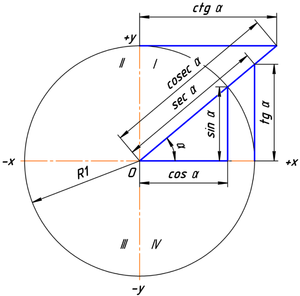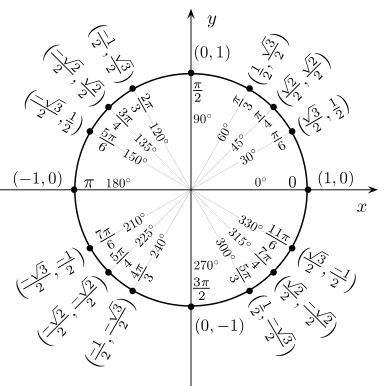Тригонометрические функции
 Из Википедии, бесплатной энциклопедии
Из Википедии, бесплатной энциклопедии

Графики тригонометрических функций: синуса, косинуса, тангенса, котангенса, секанса, косеканса
Тригонометри́ческие фу́нкции — элементарные функции[1], которые исторически возникли при рассмотрении прямоугольных треугольников и выражали зависимости длин сторон этих треугольников от острых углов при гипотенузе (или, что равнозначно, зависимость хорд и высот от центрального угла дуги в круге). Эти функции нашли широкое применение в самых разных областях науки. По мере развития математики определение тригонометрических функций было расширено, в современном понимании их аргументом может быть произвольное вещественное или комплексное число.
Раздел математики, изучающий свойства тригонометрических функций, называется тригонометрией.
К тригонометрическим функциям традиционно причисляют:
- прямые тригонометрические функции:
- синус ();
- косинус ();
- производные тригонометрические функции:
- тангенс ;
- котангенс ;
- секанс ;
- косеканс ;
- арксинус, арккосинус и т. д.
В типографике литературы на разных языках сокращённое обозначение тригонометрических функций различно, например, в англоязычной литературе тангенс, котангенс и косеканс обозначаются , , . До Второй мировой войны в Германии и во Франции эти функции обозначались так же, как принято в русскоязычных текстах[2], но потом в литературе на языках этих стран был принят англоязычный вариант записи тригонометрических функций.
Кроме этих шести широко известных тригонометрических функций, иногда в литературе используются некоторые редко используемые тригонометрические функции (версинус и т. д.).
Синус и косинус вещественного аргумента представляют собой периодические, непрерывные и бесконечно дифференцируемые вещественнозначные функции. Остальные четыре функции на вещественной оси также вещественнозначны, периодичны и бесконечно дифференцируемы, за исключением счётного числа разрывов второго рода: у тангенса и секанса в точках , а у котангенса и косеканса — в точках .
Графики тригонометрических функций показаны на рис. 1.
Способы определения[править | править код]
Определение для любых углов[править | править код]

Определение тригонометрических функций
Обычно тригонометрические функции определяются геометрически[3]. В декартовой системе координат на плоскости построим окружность единичного радиуса () с центром в начале координат . Всякий угол станем рассматривать как поворот от положительного направления оси абсцисс до некоторого луча (точку выбираем на окружности), при этом направление поворота против часовой стрелки считаем положительным, а по часовой стрелке — отрицательным. Абсциссу точки обозначим , а ординату — (см. рисунок 2).

Численные значения тригонометрических функций угла в тригонометрической окружности с радиусом, равным единице
Синусом угла называется ордината точки единичной окружности, где получается поворотом на угол в положительном направлении (против часовой стрелки), если , и в отрицательном (по часовой стрелке), если .
Косинусом угла называется абсцисса точки единичной окружности, где получается поворотом на угол в положительном направлении (против часовой стрелки), если , и в отрицательном (по часовой стрелке), если .
Тангенсом угла называется отношение ординаты точки единичной окружности к её абсциссе, причём точка не принадлежит оси ординат.
Котангенсом угла называется отношение абсциссы точки единичной окружности к её ординате, причём точка не принадлежит оси абсцисс[4].
Таким образом, определения тригонометрических функций выглядят следующим образом:
- , ;
- , ;
- , .
Нетрудно видеть, что такое определение также основывается на отношениях прямоугольного треугольника, с тем отличием, что учитывается знак (). Поэтому тригонометрические функции можно определить и по окружности произвольного радиуса , однако формулы придётся нормировать. На рисунке 3 показаны величины тригонометрических функций для единичной окружности.
В тригонометрии удобным оказывается вести счёт углов не в градусной мере, а в радианной. Так, угол в запишется длиной единичной окружности . Угол в равен, соответственно и так далее. Заметим, что угол на отличающийся от по рисунку эквивалентен , вследствие чего заключим, что тригонометрические функции периодичны.
Наконец, определим тригонометрические функции вещественного числа тригонометрическими функциями угла, радианная мера которого равна .
Определение для острых углов[править | править код]

Тригонометрические функции острого угла

В геометрии тригонометрические функции острого угла определяются отношениями сторон прямоугольного треугольника[5]. Пусть — прямоугольный (угол прямой), с острым углом и гипотенузой . Тогда:
- (синусом угла называется отношение противолежащего катета к гипотенузе). Синус можно рассматривать как «коэффициент сжатия» длины отрезка при наблюдении за ним под углом, то есть насколько укорачивается проекция отрезка при его наклоне на определенный угол[6].
- (косинусом угла называется отношение прилежащего катета к гипотенузе);
- (тангенсом угла называется отношение противолежащего катета к прилежащему). Тангенс можно рассматривать как масштабирующий коэффициент или коэффициент сравнения: насколько противолежащий катет больше прилежащего. Если тангенс равен 1, то катеты равны. Данное свойство используется в математическом анализе в определении производной: насколько изменение единицы измерения ординаты больше изменения единицы измерения абсциссы. Если тангенс равен 1, то изменения единиц измерения равны. В геометрии тангенс является безразмерной величиной (длина противолежащего катета ∕ длина прилежащего катета, м ∕ м), но применительно к вычислению производной тангенс может иметь размерность, например, скорость тела есть путь ∕ время, то есть м ∕ с.
- (котангенсом угла называется отношение прилежащего катета к противолежащему);
- (секансом угла называется отношение гипотенузы к прилежащему катету) .
- (косекансом угла называется отношение гипотенузы к противолежащему катету).
Данное определение имеет некоторое методическое преимущество, так как не требует введения понятия системы координат, но также и такой крупный недостаток, что невозможно определить тригонометрические функции даже для тупых углов, которые необходимо знать при решении элементарных задач о тупоугольных треугольниках. (См.: теорема синусов, теорема косинусов).
Определение как решений дифференциальных уравнений[править | править код]
Синус и косинус можно определить как единственные функции, вторые производные которых равны самим функциям, взятым со знаком минус:
То есть задать их как чётное (косинус) и нечётное (синус) решения дифференциального уравнения
с дополнительными условиями: для косинуса и для синуса.
Из приведенных решений следует важный вывод для теории радиотехнических цепей: синусоидальный сигнал не искажает свою форму при прохождении по RCL-цепям, искажаются только амплитуда и фаза. Подобным свойством обладает экспонента, но она не является периодической функцией.[значимость факта?]
Определение как решений функциональных уравнений[править | править код]
Функции косинус и синус можно определить[7] как решения ( и соответственно) системы функциональных уравнений:
при дополнительных условиях:
и при .
Определение через ряды[править | править код]
Используя геометрию и свойства пределов, можно доказать, что производная синуса равна косинусу, и что производная косинуса равна минус синусу. Тогда можно воспользоваться теорией рядов Тейлора и представить синус и косинус в виде степенны́х рядов:
Пользуясь этими формулами, а также равенствами и можно найти разложения в ряд и других тригонометрических функций:
где
- — числа Бернулли,
- — числа Эйлера.
Значения тригонометрических функций для некоторых углов[править | править код]
Значения синуса, косинуса, тангенса, котангенса, секанса и косеканса для некоторых углов приведены в таблице. («» означает, что функция в указанной точке не определена, а в её окрестности стремится к бесконечности).

| Радианы | ||||||||
|---|---|---|---|---|---|---|---|---|
| Градусы | ||||||||
Значения тригонометрических функций нестандартных углов[править | править код]
| Радианы | |||||||||
|---|---|---|---|---|---|---|---|---|---|
| Градусы | |||||||||
| Радианы | ||||||||
|---|---|---|---|---|---|---|---|---|
| Градусы | ||||||||
Свойства тригонометрических функций[править | править код]
Простейшие тождества[править | править код]
Поскольку синус и косинус являются соответственно ординатой и абсциссой точки, соответствующей на единичной окружности углу α, то согласно уравнению единичной окружности () или теореме Пифагора имеем для любого :
Это соотношение называется основным тригонометрическим тождеством.
Разделив это уравнение на квадрат косинуса и синуса соответственно, получим:
Из определения тангенса и котангенса следует, что
Любую тригонометрическую функцию можно выразить через любую другую тригонометрическую функцию с тем же аргументом (с точностью до знака из-за неоднозначности раскрытия квадратного корня). Нижеприведённые формулы верны для :
| sin | cos | tg | ctg | sec | cosec | |
|---|---|---|---|---|---|---|







































































































































































































































